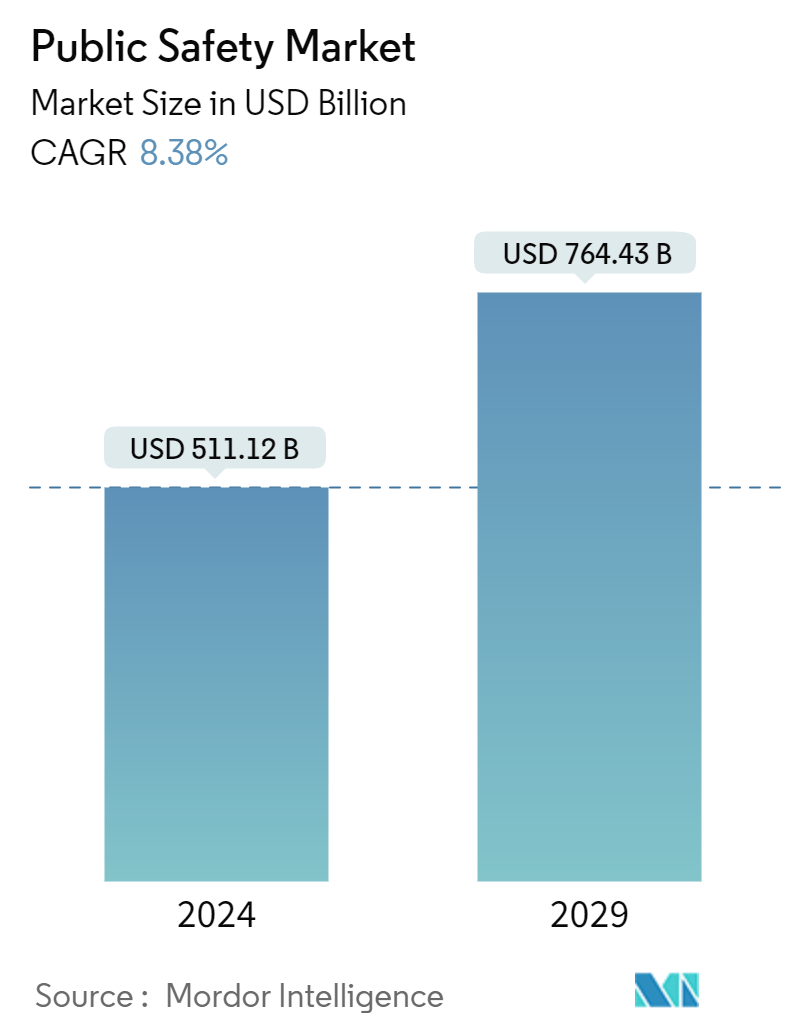Market Size of Public Safety Industry

| Study Period | 2019 - 2029 |
| Market Size (2024) | USD 511.12 Billion |
| Market Size (2029) | USD 764.43 Billion |
| CAGR (2024 - 2029) | 8.38 % |
| Fastest Growing Market | Asia Pacific |
| Largest Market | North America |
Major Players
*Disclaimer: Major Players sorted in no particular order |
Public Safety Market Analysis
The Public Safety Market size is estimated at USD 511.12 billion in 2024, and is expected to reach USD 764.43 billion by 2029, growing at a CAGR of 8.38% during the forecast period (2024-2029).
The increase in the number of terrorist attacks and criminal activities across the world acts as one of the major factors propelling the growth of the public safety market.
• The rise in global catastrophic accidents, crime rates, and terrorist activities has increased concerns for public safety worldwide. As governments and organizations strive to mitigate these risks, there's an increased emphasis on investing in advanced technologies and solutions tailored to public safety. This has catalyzed the growth of the public safety market, with demand surging for innovative tools such as surveillance systems, predictive analytics, and emergency response platforms.
• Moreover, adopting smart city initiatives drives the need for interconnected public safety solutions, enhancing situational awareness and response coordination.
• Moreover, integrating surveillance systems, sensors, and real-time monitoring tools enables quicker incident responses, thus bolstering overall public safety. The proliferation of smart devices and wearable tech further contributes to the data pool, allowing the authorities to gather real-time insights into crowd behavior and emergencies. In addition, the advent of smart transportation systems facilitates efficient emergency response and evacuation procedures during crises.
• The increased adoption of the internet and IoT adoption also propels the growth of smart cities and platforms worldwide. As a result of urbanization, smart cities are expanding worldwide, fueling market development.
• However, a considerable amount of time, cost, and commitment is essential to modernize traditional public safety organizations. This poses a significant challenge for vendors to increase the uptake of digital technology among key public service organizations, specifically police service stations.
• Macroeconomic factors have a significant impact on the public safety market. For instance, solid economic growth typically correlates with lower crime rates as people have better job opportunities and higher incomes, reducing the incentive to engage in criminal activities. On the other side, the rise in the unemployment rate can lead to increased crime, creating an opportunity for the market studied to grow.
Public Safety Industry Segmentation
Public safety refers to the welfare and protection of the public, usually expressed as a government responsibility. Most states have departments for public safety. The department's primary goal is to protect the public from dangers affecting safety, such as crimes or disasters. This is achieved by collaboration with private organizations for technology and other support services. The partnership will help government organizations achieve public safety. The public safety market is defined by the revenue generated from public safety solutions and services offered by various players operating in the market.
The public safety market is segmented by component (solution and services), deployment type (on-premise and cloud), end-user vertical (law enforcement, medical, firefighting, transportation, disaster management, other end-user verticals), geography (North America [United States and Canada], Europe, Asia Pacific, Middle East and Africa, Latin America). The report offers market forecasts and size in value (USD) for all the above segments.
| By Component | |
| Solution | |
| Services |
| By Deployment Type | |
| On-premise | |
| Cloud |
| By End-user Vertical | |
| Law Enforcement | |
| Medical | |
| Firefighting | |
| Transportation | |
| Disaster Management | |
| Other End-user Verticals |
| By Geography*** | ||||
| ||||
| Europe | ||||
| Asia | ||||
| Australia and New Zealand | ||||
| Middle East and Africa | ||||
| Latin America |
Public Safety Market Size Summary
The public safety industry is experiencing significant growth, driven by increasing global concerns over terrorism, crime, and catastrophic events. This has led to a heightened focus on investing in advanced technologies and solutions designed to enhance public safety. The adoption of smart city initiatives is further propelling the demand for interconnected safety solutions, which improve situational awareness and response coordination. The integration of surveillance systems, sensors, and real-time monitoring tools is enabling quicker incident responses, thereby bolstering overall public safety. Additionally, the proliferation of smart devices and wearable technology is contributing to a richer data pool, allowing authorities to gather real-time insights into crowd behavior and emergencies. However, the modernization of traditional public safety organizations poses challenges, requiring substantial time, cost, and commitment to increase the uptake of digital technology among key public service organizations.
The public safety market is highly fragmented, with both global players and small to medium-sized enterprises competing for market share. Major companies such as Cisco Systems Inc., General Dynamics Corporation, IBM Corporation, Blackberry Limited, and L3Harris Technologies Inc. are actively engaging in partnerships and acquisitions to enhance their product offerings and secure a competitive edge. The market's growth is further supported by macroeconomic factors, with solid economic growth typically correlating with lower crime rates, while rising unemployment can lead to increased crime, creating opportunities for market expansion. In the Asia-Pacific region, rapid urbanization and technological advancements like AI, IoT, and cloud computing are driving demand for robust safety and emergency response systems. Government investments in public safety infrastructure and initiatives, along with the rise of smart city projects, are expected to significantly boost market development.
Public Safety Market Size - Table of Contents
-
1. MARKET INSIGHTS
-
1.1 Market Overview
-
1.2 Industry Attractiveness - Porter's Five Forces Analysis
-
1.2.1 Bargaining Power of Suppliers
-
1.2.2 Bargaining Power of Buyers/Consumers
-
1.2.3 Threat of New Entrants
-
1.2.4 Threat of Substitutes
-
1.2.5 Intensity of Competitive Rivalry
-
-
1.3 Impact of Macroeconomic Trends on the Market
-
1.4 Ecosystem Analysis
-
1.5 Technology Snapshot
-
1.6 Insights on the Latest Trends
-
1.6.1 Integration With Next-generation Technologies and Interoperable Record Systems
-
1.6.2 Incorporation of Advanced Camera Variations
-
1.6.3 Higher Enforcement of Geospatial Intelligence and Predictive Monitoring
-
-
-
2. MARKET SEGMENTATION
-
2.1 By Component
-
2.1.1 Solution
-
2.1.2 Services
-
-
2.2 By Deployment Type
-
2.2.1 On-premise
-
2.2.2 Cloud
-
-
2.3 By End-user Vertical
-
2.3.1 Law Enforcement
-
2.3.2 Medical
-
2.3.3 Firefighting
-
2.3.4 Transportation
-
2.3.5 Disaster Management
-
2.3.6 Other End-user Verticals
-
-
2.4 By Geography***
-
2.4.1 North America
-
2.4.1.1 United States
-
2.4.1.2 Canada
-
-
2.4.2 Europe
-
2.4.3 Asia
-
2.4.4 Australia and New Zealand
-
2.4.5 Middle East and Africa
-
2.4.6 Latin America
-
-
Public Safety Market Size FAQs
How big is the Public Safety Market?
The Public Safety Market size is expected to reach USD 511.12 billion in 2024 and grow at a CAGR of 8.38% to reach USD 764.43 billion by 2029.
What is the current Public Safety Market size?
In 2024, the Public Safety Market size is expected to reach USD 511.12 billion.

